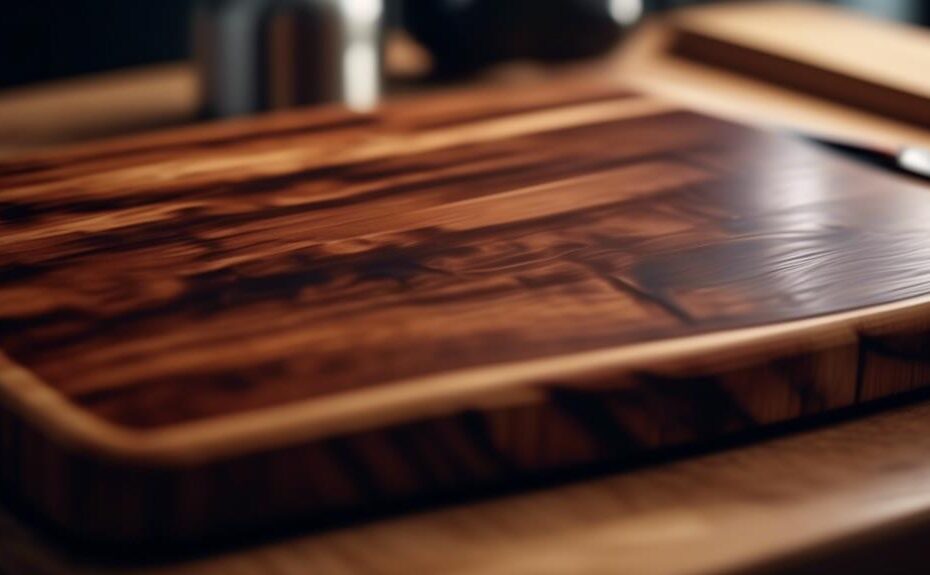Properly sealing and finishing a wooden cutting board is crucial for its care and maintenance. It not only enhances the board's natural beauty but also protects it from moisture and bacteria.
In this guide, we will walk you through the process, from selecting the right oil to maintaining and re-sealing the board.
So, if you want to ensure the longevity and functionality of your cutting board, keep reading for some expert tips and tricks.
Key Takeaways
- Consider factors such as durability, food safety, and ease of application when selecting the right type of oil for your wooden cutting board.
- Beeswax is a natural alternative that provides a protective barrier against moisture and bacteria. It is food-safe and easy to apply.
- Food grade mineral oil is specifically designed for wooden cutting boards. It prevents water absorption, is odorless, tasteless, and safe for food contact.
- Ensure the cutting board is clean, smooth, and free from defects or imperfections before applying a sealant. Sand the board with coarse-grit sandpaper to remove roughness, then use fine-grit sandpaper for a smooth finish. Clean the board thoroughly with mild soap and water before applying the sealant.
Selecting the Right Type of Oil
When selecting the right type of oil for sealing and finishing a wooden cutting board, it is important to consider factors such as durability, food safety, and ease of application.
One natural alternative to oil is beeswax, which offers several benefits. Beeswax is a natural product that provides a protective barrier against moisture and bacteria, ensuring the longevity of the cutting board. It is also food-safe, making it an ideal choice for those concerned about the chemicals present in other types of sealants. Additionally, beeswax is easy to apply and can be reapplied as needed to maintain the board's integrity.
Another option to consider is food grade mineral oil. This type of oil is specifically designed for use on wooden cutting boards, providing a protective layer that prevents water absorption and minimizes the risk of warping or cracking. It is odorless, tasteless, and safe for contact with food, making it an excellent choice for maintaining the quality of wooden cutting boards.
Preparing the Cutting Board Surface
To properly prepare the cutting board surface for sealing and finishing, it is essential to ensure that it is clean, smooth, and free from any defects or imperfections. The first step in preparing the cutting board is sanding. Start by using a coarse-grit sandpaper to remove any roughness or unevenness on the surface. Work your way up to a fine-grit sandpaper to achieve a smooth finish. Be sure to sand in the direction of the grain to avoid damaging the wood fibers.
After sanding, it is important to clean the cutting board thoroughly to remove any dust or debris. Use a damp cloth or sponge and mild soap to wipe down the entire surface. Rinse well and allow the cutting board to dry completely before moving on to the next step.
Once the cutting board is clean and dry, it is time to apply a food-safe sealant. Look for sealants specifically designed for cutting boards, as they are non-toxic and safe for food contact. Apply the sealant according to the manufacturer's instructions, making sure to coat the entire surface evenly. Allow the sealant to dry completely before using the cutting board.
Applying the Sealant and Finish

To properly seal and finish a wooden cutting board, it is crucial to select a food-safe sealant and apply it evenly across the entire surface. Applying the sealant and finish requires certain techniques to achieve a smooth and even result. Here are some key techniques to consider:
- Start by sanding the board to create a smooth surface.
- Apply the sealant in thin, even coats, following the manufacturer's instructions.
- Use a clean, lint-free cloth to wipe off any excess sealant.
- Allow each coat to dry completely before applying the next one.
- Apply multiple coats for a more durable finish.
To ensure a successful outcome, it is important to avoid common mistakes when applying the sealant and finish. These mistakes include:
- Applying too much sealant, which can result in a sticky or uneven finish.
- Not allowing sufficient drying time between coats, leading to a tacky surface.
- Using the wrong type of sealant, which may not be food-safe or suitable for wooden surfaces.
Maintaining and Re-sealing the Cutting Board
Regular maintenance and re-sealing of a wooden cutting board is essential to ensure its longevity and hygienic use in the kitchen. Cleaning and disinfecting the cutting board surface should be done after each use to remove any food particles and bacteria. To clean the board, use hot soapy water and a sponge or brush. Rinse thoroughly and dry completely before storing.
Disinfecting can be done by wiping the board with a mixture of vinegar and water or hydrogen peroxide. It is important to regularly oil the cutting board to prevent it from drying out and cracking. Apply a food-safe mineral oil or beeswax to the board and let it soak for a few hours. Wipe off the excess oil and repeat this process every few months or as needed.
Regular maintenance and re-sealing will ensure that your wooden cutting board remains in top condition for years to come.
Frequently Asked Questions
How Often Should I Reseal and Finish My Wooden Cutting Board?
The resealing frequency of a wooden cutting board depends on usage and maintenance. It is generally recommended to reseal and finish the board every few months. There are alternative sealing options, such as mineral oil or beeswax, that can also be considered.
Can I Use Vegetable Oil to Seal and Finish My Wooden Cutting Board?
Using vegetable oil as an alternative sealant for wooden cutting boards is a common practice due to its food-grade properties. It provides a natural, non-toxic barrier that helps protect the wood and maintain its longevity.
Can I Use My Wooden Cutting Board Immediately After Applying the Sealant and Finish?
Using a food-safe sealant and finish is essential for preserving and protecting a wooden cutting board. After applying the sealant and finish, it is important to allow sufficient drying time before using the board to ensure optimal results and safety.
Can I Use Sandpaper to Prepare the Cutting Board Surface?
Using sandpaper to prepare the cutting board surface is a common practice to ensure a smooth and even finish. However, it is essential to choose the right grit and follow proper sanding techniques to avoid damaging the wood. Additionally, there are alternative sealants available for wooden cutting boards, such as food-grade mineral oil or beeswax, which can provide a protective barrier while being safe for food contact.
How Long Should I Let the Sealant and Finish Dry Before Using the Cutting Board?
Proper drying time for sealant and finish on a wooden cutting board is crucial to ensure its longevity and safety. It is important to choose the right sealant and finish that will effectively protect the board from moisture and bacteria.
Conclusion
Properly sealing and finishing a wooden cutting board is essential to ensure its longevity and hygiene. By selecting the right type of oil, preparing the surface, and applying a sealant and finish, you can protect the wood from moisture and bacteria.
Regular maintenance and re-sealing will keep the cutting board in optimal condition.
Just as a well-maintained cutting board becomes a reliable tool in the kitchen, taking care of other aspects of our lives can lead to long-lasting success and fulfillment.




